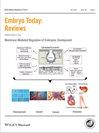The neural crest: A versatile organ system
Q Medicine
引用次数: 59
Abstract
The neural crest is the name given to the strip of cells at the junction between neural and epidermal ectoderm in neurula-stage vertebrate embryos, which is later brought to the dorsal neural tube as the neural folds elevate. The neural crest is a heterogeneous and multipotent progenitor cell population whose cells undergo EMT then extensively and accurately migrate throughout the embryo. Neural crest cells contribute to nearly every organ system in the body, with derivatives of neuronal, glial, neuroendocrine, pigment, and also mesodermal lineages. This breadth of developmental capacity has led to the neural crest being termed the fourth germ layer. The neural crest has occupied a prominent place in developmental biology, due to its exaggerated migratory morphogenesis and its remarkably wide developmental potential. As such, neural crest cells have become an attractive model for developmental biologists for studying these processes. Problems in neural crest development cause a number of human syndromes and birth defects known collectively as neurocristopathies; these include Treacher Collins syndrome, Hirschsprung disease, and 22q11.2 deletion syndromes. Tumors in the neural crest lineage are also of clinical importance, including the aggressive melanoma and neuroblastoma types. These clinical aspects have drawn attention to the selection or creation of neural crest progenitor cells, particularly of human origin, for studying pathologies of the neural crest at the cellular level, and also for possible cell therapeutics. The versatility of the neural crest lends itself to interlinked research, spanning basic developmental biology, birth defect research, oncology, and stem/progenitor cell biology and therapy.神经嵴:一个多功能的器官系统
神经嵴是指神经节期脊椎动物胚胎中位于神经和表皮外胚层交界处的细胞条,随着神经褶皱的上升,这些细胞条随后被带到背神经管。神经嵴是一个异质性和多能性的祖细胞群,其细胞经过EMT,然后在整个胚胎中广泛而准确地迁移。神经嵴细胞几乎对身体的每个器官系统都有贡献,包括神经元、神经胶质、神经内分泌、色素和中胚层谱系的衍生物。这种发育能力的广度导致神经嵴被称为第四胚层。神经嵴因其广泛的迁移形态发生和广泛的发育潜力,在发育生物学中占有重要地位。因此,神经嵴细胞已成为发育生物学家研究这些过程的一个有吸引力的模型。神经嵴发育的问题会引起一些人类综合症和出生缺陷,统称为神经嵴病变;这些包括Treacher Collins综合征、巨结肠病和22q11.2缺失综合征。神经嵴谱系中的肿瘤也具有临床重要性,包括侵袭性黑色素瘤和神经母细胞瘤类型。这些临床方面引起了人们对神经嵴祖细胞的选择或创造的关注,特别是人类起源的神经嵴祖细胞,用于在细胞水平上研究神经嵴病理,也用于可能的细胞治疗。神经嵴的多功能性使其成为相互关联的研究,涵盖基础发育生物学、出生缺陷研究、肿瘤学和干细胞/祖细胞生物学和治疗。出生缺陷研究(C辑)(2):275 - 298,2014。©2014 Wiley期刊公司
本文章由计算机程序翻译,如有差异,请以英文原文为准。
求助全文
约1分钟内获得全文
求助全文
来源期刊

Birth Defects Research Part C-Embryo Today-Reviews
DEVELOPMENTAL BIOLOGY-
CiteScore
3.65
自引率
0.00%
发文量
0
审稿时长
>12 weeks
期刊介绍:
John Wiley & Sons and the Teratology Society are please to announce a new journal, Birth Defects Research . This new journal is a comprehensive resource of original research and reviews in fields related to embryo-fetal development and reproduction. Birth Defects Research draws from the expertise and reputation of two current Wiley journals, and introduces a new forum for reviews in developmental biology and embryology. Part C: Embryo Today: Reviews
 求助内容:
求助内容: 应助结果提醒方式:
应助结果提醒方式:


